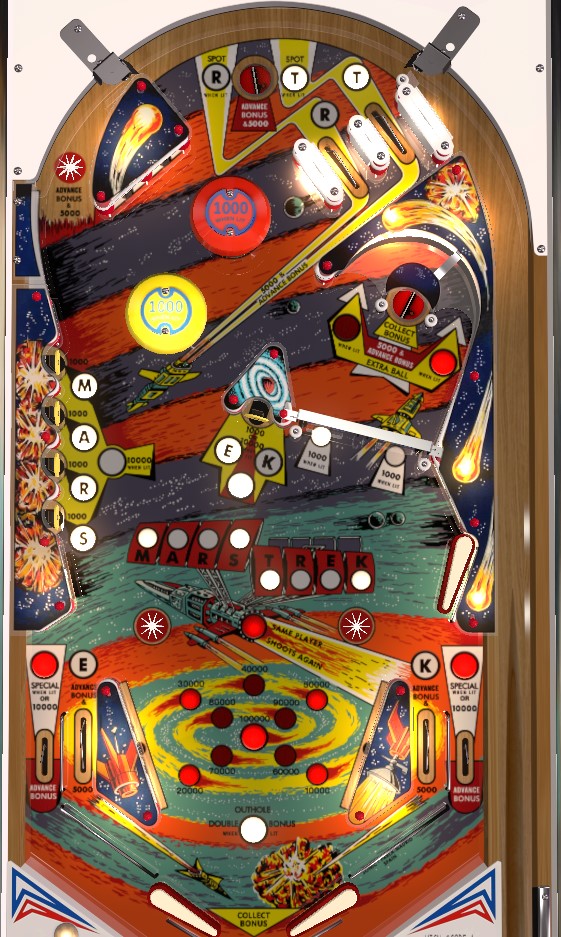Mars Trek's ruleset boils down to be relatively simple, but the table layout is highly conducive to house balls, quick out lane drains, and drains that require a lot of nudging in advance to avoid. Know how the ball feeds down from the top of the table through the R and T lanes and nudge accordingly to get ball on flipper- a rebound off the wall below the S target and directly into the center is common.
Build bonus at left orbit/star rollovers, top lanes, top saucer, right horseshoe, or in lanes. Collect E and K from in lanes or center target to double bonus. Right saucer in front of horseshoe collects + resets the unmultiplied bonus. When bonus is maxed, one of the spinners is lit for 1,000 per spin.

The plunge is likely to end up in either the top saucer or one of two top lanes. All three of these score 5,000 points and a bonus advance.
The saucer alternates being lit for the T or R in Trek, switching between the two every time a 5,000-point switch is registered. The saucer fires slightly to the right of straight down; this kickout may or may not interact with the orange pop bumper or the triangle-shaped structure in the center of the playfield.
The top lanes always give the T or R as indicated. The exit of these lanes hits a wall that directs the ball down and left. This feed is extremely dangerous; depending on the setup of the exact copy you're playing, this may funnel the ball directly into the left out lane, or the ball may bounce off of the wall below the S target on the left and into the center drain from there. Practice on this machine where possible to get a feel for the range of outcomes here and develop a nudge strategy as necessary just to get the ball on a flipper.
Lit bumpers score 1,000 points. Unlit bumpers score 100. One bumper will be lit at a time, alternating whenever a 5,000-point switch is scored.
The four standup targets on the left side of the game award the letters in Mars. These targets score 1,000 points; hit a lit target to unlight it. If all 4 letters in Mars are collected, the value of these targets increases to 10,000 points for the rest of the ball.
The T and R in Trek can be collected from the top saucer or top lanes as described above in the On the plunge section. The E and K can also be collected in two ways. The center standup target scores 1,000 points and either the E or the K, alternating with each 5,000-point switch that gets triggered. E and K are also always available at the in lanes, which score 5,000 points and a bonus advance themselves. Collecting both the E and K in Trek lights double bonus, which only applies to the end of ball bonus. Spelling Trek lights the center standup target for 10,000 points for the rest of the ball. If you shoot at the center target, do so with the left flipper; the center target's angle means shots from the right flipper very frequently end up out of control and near the left out lane.
The two star rollovers just above the slingshots and the left orbit star rollover score 5,000 points and a bonus advance. The left orbit is almost always the ideal shot for a ball on the right flipper.
The two spinners score 100 points per spin by default. If the current base bonus is maxed out at 100,000 points, one of the two spinners will be lit for 1,000 points per spin, alternating with each 5,000-point switch hit. Putting the ball through the horseshoe in either direction scores an extra ball if the current base bonus is exactly 50,000 points; at any other bonus value, the horseshoe scores 5,000 points and a bonus advance.
The saucer positioned between the two horseshoe entrances is always available as a bonus collect. Collecting the bonus mid-ball in this way completely ignores the bonus multiplier; you are given the current base bonus value, which is then reset back to 10,000 points. If double bonus is lit and end of ball bonus is maxed out, it may be ideal to avoid collecting the bonus, instead focusing on 1,000 point spinners, more left orbit shots, or 10,000 point standup targets; collecting a single bonus then draining with a small double bonus soon after results in a lot of lost points compared to draining with a full double bonus.
Mars Trek has a conventional in/out lane setup. In lanes score 5,000 points and a bonus advance, as well as the E (left) and K (right) in Trek. Out lanes score 10,000 points and a bonus advance, or they can be lit alternately for Special if the entirety of Mars Trek has been spelled. Slingshots score 100 points.
End of ball bonus is a significant portion of Mars Trek scoring. Each individual bonus advance is worth 10,000 points in end of ball bonus rather than the conventional 1,000. Bonus is advanced by the top saucer, the horseshoe, any rollover lane, and any star rollover. Bonus is doubled by collecting the E and K in Trek. Max bonus is 2x 100,000 = 200,000 points. The right saucer collects single bonus only, and resets the base bonus back to 10,000 points. The horseshoe is lit for extra ball only when the base bonus is exactly 50,000 points. Base bonus, bonus multiplier, and collected Mars Trek letters never carry from ball to ball.
Extra balls and specials cannot be assigned a point value for competition/novelty play.